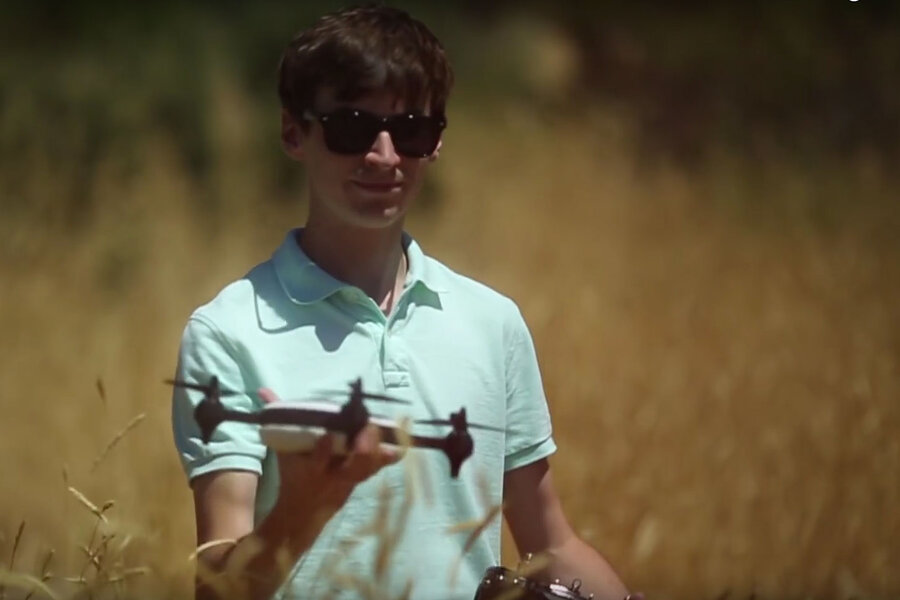Utah teen launches Teal, a versatile backpack drone
Loading...
George Matus was just 11 when he started flying model aircraft and 14 when he started building his own drones. At age 18, he has started a company to sell vehicles that do everything he himself wanted in a drone, and he has already begun to manufacture them at a plant just 15 minutes from his parents' home in Salt Lake City.
His company, called Teal, launched Wednesday with the ambitious aim of changing consumer drones from a single-purpose flying camera to a fully modular, multi-purpose tool.
For example, the Teal drone comes equipped with module to add a thermal camera, a useful application for everything ranging from search-and-rescue operations to firefighting to farming, notes MarketWatch. Another add-on module gives the drone sense-and-avoid capabilities via radar. The drone also flies at more than 70 mph – the fastest out-the-box drone in production now.
At the heart of the design is an inertial navigation system on a credit-card sized chip so advanced that it's "a flying supercomputer. You can even plug Teal into a monitor, use it like a normal computer, play games on it, and go fly when you want!" the Teal website claims.
"The goal is to make this drone and drones in the future just as ubiquitous as the smartphone is today," Mr. Matus tells The Christian Science Monitor.
The son of an entrepreneur, Matus spent his teenage years first racing, then building drones and helicopters. Matus sought out and received a $100,000 fellowship from PayPal co-founder and billionaire Peter Thiel, who has both supplemented and jumpstarted his fund.
The drone is small – small enough to fit inside a backpack, says the recent high school grad. It can reach speeds of up to 70 miles per hour, and it can fly even in 30-mile-per-hour winds – conditions that tend to keep many other drones grounded. Both the hardware and the software of the Teal drone is open to innovation, with arms that come off easily and an open software development kit that lets third-party developers build their own apps.
The drone's flexibility helps it target the relatively untested drone market of software developers, says Ryan Wood of the Salt Lake-based Rocky Mountain Unmanned Systems. Although his organization is focused on commercial drones, Mr. Wood says he has worked with Matus in Utah's small drone community for more than a year, calling him a "child prodigy."
The $1,299 price tag makes the drone an expensive hobby, but the market leader sells the DJI Phantom 4 Quadcopter for $1,399, and Matus also emphasizes the quality and personal-accessibility of a "Made in the USA" product. Wood sees the flexible-use aspects of Teal as offering the most potential for the company, as Matus has expressed hopes for developing anything from zombie-hunting drone games to search-and-rescue capabilities.
What Matus calls the "gamification of drones" is part of the everyday-drone movement Teal is trying to create. He cited Pokémon GO's ability to "take people outdoors and make video games start to come to life" and giving "the soccer mom" a means to film her child's game as goals for the new drone.
A multi-use drone such as Teal is another sign among many that UAVs are taking off. The private drone market made $720 million in 2014, but the vehicles are expected to bring in $4.5 billion by 2020, according to Business Researcher.
The market is currently dominated by China-based DJI and its camera-drone Phantom series, which controls between 50 to 70 percent of the market, Sally French reported for Market Watch.
The quest to challenge DJI has stumped US-based firms 3-D Robotics and Lily so far, but Matus says his do-it-all drone has already satisfied a champion drone-racer with years of experience – himself.
"I wanted a drone that could do all of it, I didn’t want a drone that could do one separate thing," he says. “The idea behind this company was to build a product that’s really more like a user platform and can do a lot more than just aerial photography.”








